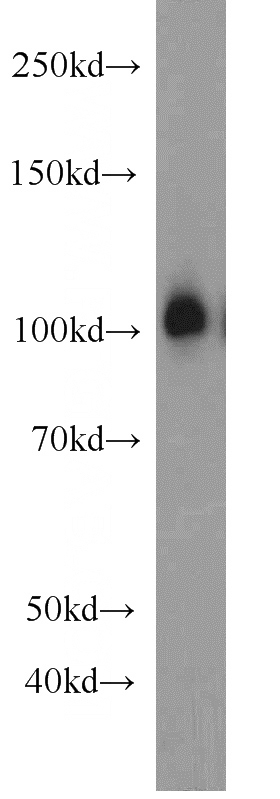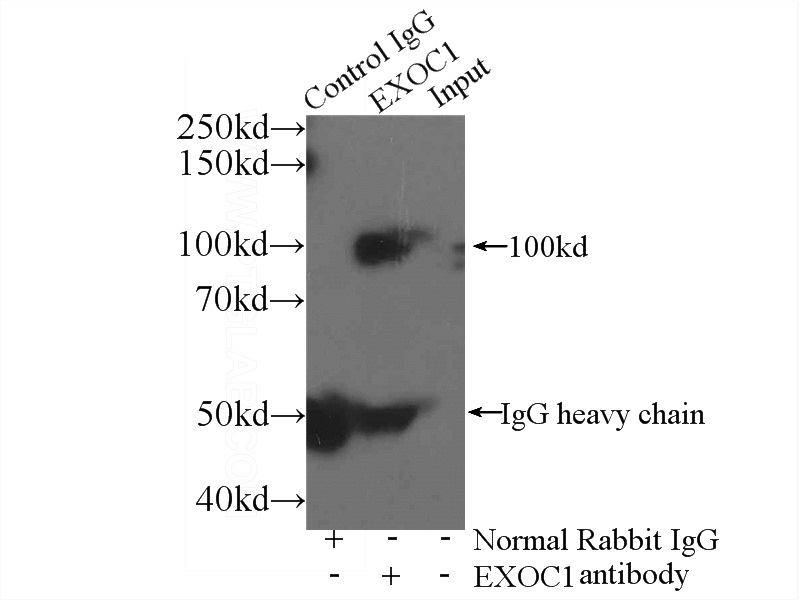-
Product Name
EXOC1 antibody
- Documents
-
Description
EXOC1 Rabbit Polyclonal antibody. Positive IHC detected in human gliomas tissue. Positive WB detected in rat brain tissue, human brain tissue, mouse brain tissue. Positive IP detected in mouse brain tissue. Observed molecular weight by Western-blot: 102 kDa
-
Tested applications
ELISA, IHC, WB, IP
-
Species reactivity
Human, Mouse, Rat; other species not tested.
-
Alternative names
BM 102 antibody; EXOC1 antibody; exOCyst complex component 1 antibody; ExOCyst complex component Sec3 antibody; FLJ10893 antibody; SEC3 antibody; SEC3L1 antibody; SEC3P antibody
- Immunogen
-
Isotype
Rabbit IgG
-
Preparation
This antibody was obtained by immunization of EX℃1 recombinant protein (Accession Number: XM_017008409). Purification method: Antigen affinity purified.
-
Clonality
Polyclonal
-
Formulation
PBS with 0.1% sodium azide and 50% glycerol pH 7.3.
-
Storage instructions
Store at -20℃. DO NOT ALIQUOT
-
Applications
Recommended Dilution:
WB: 1:500-1:5000
IP: 1:500-1:5000
IHC: 1:20-1:200
-
Validations

rat brain tissue were subjected to SDS PAGE followed by western blot with Catalog No:110501(EXoc1 antibody) at dilution of 1:1000

Immunohistochemical of paraffin-embedded human gliomas using Catalog No:110501(EXoc1 antibody) at dilution of 1:50 (under 10x lens)

IP Result of anti-EXoc1 (IP:Catalog No:110501, 3ug; Detection:Catalog No:110501 1:1000) with mouse brain tissue lysate 3600ug.
-
Background
EXoc1 (exocyst complex component 1), also known as SEC3, is a component of the exocyst complex which is essential for the targeting of exocytic vesicles to specific docking sites on the plasma membrane. The exocyst complex is an octameric complex that tethers vesicles at the plasma membrane, regulates polarized exocytosis, and recruits membranes and proteins required for nanotube formation.Recently it has been reported that exocyst complex proteins are likely a key effector of Nef-mediated enhancement of nanotube formation, and possibly microvesicle secretion, which suggests a new paradigm of exocyst involvement in polarized targeting for intercellular transfer of viral proteins and viruses.
-
References
- Ketel K, Krauss M, Nicot AS. A phosphoinositide conversion mechanism for exit from endosomes. Nature. 529(7586):408-12. 2016.
- Mukerji J, Olivieri KC, Misra V, Agopian KA, Gabuzda D. Proteomic analysis of HIV-1 Nef cellular binding partners reveals a role for exocyst complex proteins in mediating enhancement of intercellular nanotube formation. Retrovirology. 9:33. 2012.
- Neto H, Kaupisch A, Collins LL, Gould GW. Syntaxin 16 is a master recruitment factor for cytokinesis. Molecular biology of the cell. 24(23):3663-74. 2013.
- Gonzalez IM, Ackerman WE, Vandre DD, Robinson JM. Exocyst complex protein expression in the human placenta. Placenta. 35(7):442-9. 2014.
- Park SJ, Jeong J, Park YU. Disrupted-in-schizophrenia-1 (DISC1) Regulates Endoplasmic Reticulum Calcium Dynamics. Scientific reports. 5:8694. 2015.
Related Products / Services
Please note: All products are "FOR RESEARCH USE ONLY AND ARE NOT INTENDED FOR DIAGNOSTIC OR THERAPEUTIC USE"
